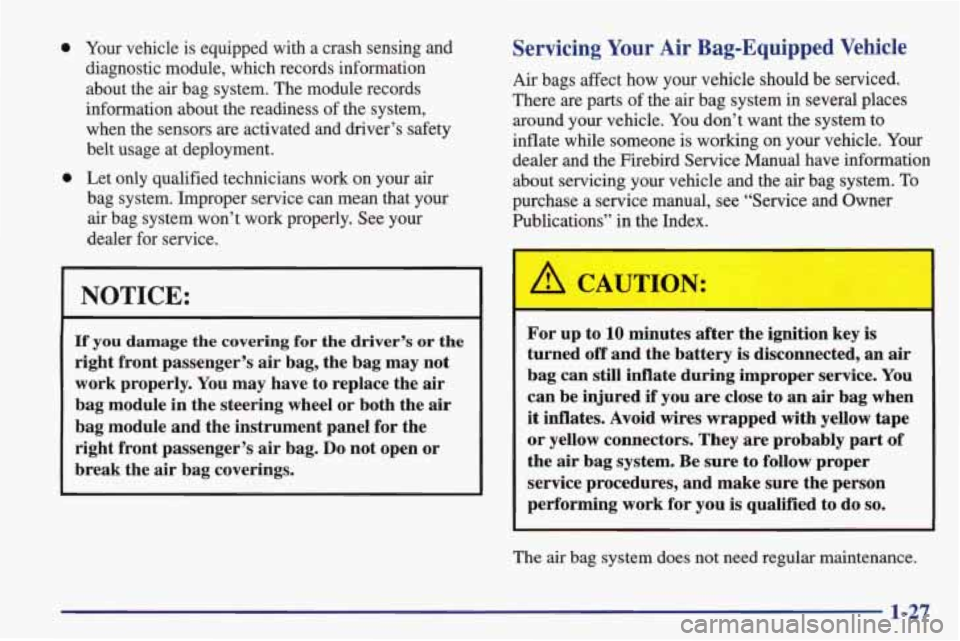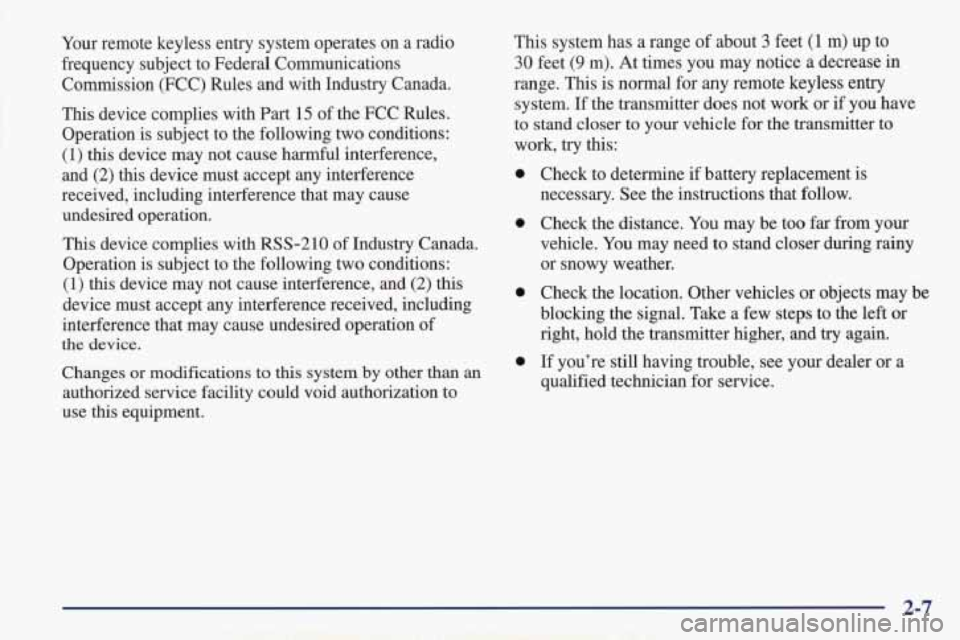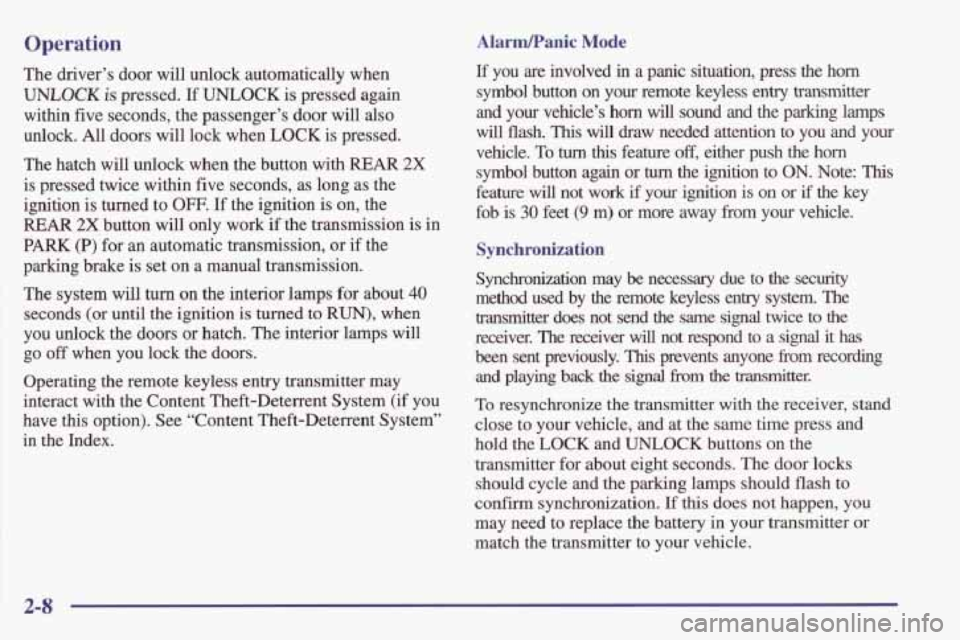key PONTIAC FIREBIRD 1998 Owners Manual
[x] Cancel search | Manufacturer: PONTIAC, Model Year: 1998, Model line: FIREBIRD, Model: PONTIAC FIREBIRD 1998Pages: 406, PDF Size: 18.23 MB
Page 29 of 406

The best way to protect the fetus is to protect the
mother. When a safety belt is
worn properly, it’s more
likely that the fetus won’t be hurt in
a crash. For
pregnant women, as for anyone, the key to making
safety belts effective is wearing them properly.
Right Front Passenger Position
The right front passenger’s safety belt works the same
way
as the driver’s safety belt. See “Driver Position”
earlier in this section.
Supplemental Restraint System (SRS)
This part explains the Supplemental Restraint System
(SRS) or air bag system.
Your vehicle has “Next Generation” reduced-force
frontal
air bags -- one air bag for the driver and another
air bag for the right front passenger.
Reduced-force frontal
air bags are designed to help
reduce the risk of injury from
the force of an inflating
air bag. But even these air bags must inflate very
quickly if they are to do their job and comply with
federal regulations. Here
are the most important things
to know about the air
bag system:
r
I A CAUTION: -
You can be severely injured or killed in a crash if
you aren’t wearing your safety belt -- even if you
have air bags. Wearing your safety belt during a
crash helps reduce
your chance of hitting things
inside the vehicle or being ejected from it.
Air
bags are “supplemental restraints’’ to the
safety belts. All air bags -- even reduced-force
air bags
-- are designed to work with safety belts,
but don’t replace them. Air
bags are designed to
work only in moderate
to severe crashes where
the front of your vehicle hits something. They
aren’t designed to inflate at all in rollover, rear,
side or low-speed frontal crashes. And, for
unrestrained occupants, reduced-force air bags
may provide less protection in frontal crashes
than more forceful air
bags have provided in the
past. Everyone in your vehicle should wear a
safety belt properly
-- whether or not there’s an
air
bag for that person.
1-22
Page 34 of 406

0 0 Your vehicle is equipped with a crash sensing and
diagnostic module, which records information
about the air bag system. The module records
information about the readiness of the system,
when the sensors are activated and driver’s safety belt usage at deployment.
Let only qualified technicians work on your air
bag system. Improper service can mean that your
air bag system won’t work properly. See your
dealer for service.
NOTICE:
I ~~
If you damage the covering for the driver’s or the
right front passenger’s air bag, the bag may not
work properly. You may have to replace the air
bag module in the steering wheel or both the air
right front passenger’s
air bag. Do not open or
break the
air bag coverings.
~ bag module and the instrument panel for the
Servicing Your Air Bag-Equipped Vehicle
Air bags affect how your vehicle should be serviced.
There are parts of the air bag system in several places
around your vehicle. You don’t want the system to
inflate while someone is working on your vehicle. Your
dealer and the Firebird Service Manual have information
about servicing your vehicle and the air bag system.
To
purchase a service manual, see “Service and Owner
Publications’’
in the Index.
CAUTION:
I
For up to 10 minutes after the ignition key is
turned
off and the battery is disconnected, an air
bag can still inflate during improper service. You
can be injured
if you are close to an air bag when
it inflates. Avoid wires wrapped with yellow tape
or yellow connectors. They are probably part of
the air bag system. Be sure to follow proper
service procedures, and make sure the person
performing work for you
is qualified to do so.
The air bag system does not need regular maintenance.
1-27
Page 56 of 406

Section 2 Features and Controls
Here you can learn about the many standard and optional features on your vehicle, and inform\
ation on starting,
shifting and braking. Also explained are the instrument panel a\
nd the warning systems that tell you if everything
is
working properly -- and what to do if you have a problem.
2-2
2-4
2-6
2-11
2-13
2- 14
2-17
2-18
2-23
2-24
2-26 2-29
2-30
2-35
2-39
2-4 1
Keys
Door Locks
Remote Keyless Entry System
Hatch Theft
Content Theft-Deterrent System
(If Equipped)
PASS-Key@
I1
Feature Customization (If Equipped)
New Vehicle “Break-In”
Ignition Positions Starting Your Engine
Engine Coolant Heater (Canada Only)
Automatic Transmission Operation
Manual Transmission Operation
Shifting Into PARK (P)
(Automatic Transmission Only)
Shifting Out of PARK (P)
(Automatic Transmission)
2-4 1
2-42
2-42
2-43
2-44
2-45
2-46
2-46 2-52
2-55
2-57
2-58
2-62
2-69
2-76
2-79
Parking Your Vehicle (Manual Transmission)
Parking Over Things That Burn
Engine Exhaust
Running Your Engine While You’re Parked
(Automatic Transmission)
Parking Brake
Windows
Tilt Steering Wheel
Turn SignalMultifunction Lever
Exterior Lamps Interior Lamps
Mirrors Storage Compartments
%in Lift-off Roof Panels
(If Equipped)
Convertible
Top
Instrument Panel
Waming Lights, Gages and Indicators
2-1
Page 57 of 406

Keys
A CAUTION:
Leaving young children in a vehicle with the
ignition key is dangerous for many reasons.
A child or others could be badly injured or
even killed.
They could operate power windows
or other
controls or even make the vehicle move. Don’t
leave the keys
in a vehicle with young children.
2-2
Page 58 of 406

The ignition keys are
I for the ignition only.
The door keys
are for the
doors and all other locks.
When
a new vehicle is delivered, the dealer removes the
bar coded tags from the door keys and gives them to the
first owner. The
ignition keys don't have plugs. Instead they have
bar-coded key tags. These tags may be removed by
your dealer or even before the vehicle is delivered to
your dealer.
Each plug has a code on it that tells your dealer or
a
qualified locksmith how to make extra door keys. Keep
the plugs in a safe place.
If you lose your door keys,
you'll be able to have new ones made using these plugs.
If you need a new ignition key, contact your dealer who
can obtain the correct key code. Remember to carry the
pre-cut emergency key which Pontiac sends after delivery (this service is not available in Canada). In an
emergency, call Pontiac Roadside Assistance at
1-800-ROADSIE or 1-800-762-3743.
(In Canada call 1-800-268-6800.)
I NOTICE:
Your vehicle has a number of new features that
can help prevent theft. But you can have a lot
of
trouble getting into your vehicle if you ever lock
your keys inside.
You may even have to damage
your vehicle
to get in. So be sure you have
extra keys.
2-3
Page 59 of 406

Door Locks
A CAU-ION:
I
Unlocked doors can be dangerous.
Passengers
-- especially children -- can easily
open the doors and fall out. When
a door is
locked, the inside handle won’t open
it.
Outsiders can easily enter through an unlocked
door when you slow down or stop your vehicle.
This may not be so obvious: You increase the
chance of being thrown out
of the vehicle in a
crash
if the doors aren’t locked. Wear safety belts
properly, lock your doors, and you
will be far
better off whenever you drive your vehicle.
There are several ways to lock
and unlock your vehicle.
From the outside, use
your door key. If your vehicle has
the Content Theft-Deterrent System and it is med,
unlocking and opening a door this way will set off the
alarm. See “Content Theft-Deterrent System” in the Index.
L
To lock the door from the inside, slide the lock control
on the door rearward.
To unlock the door, slide the lock control on the
door
forward.
2-4 ’
Page 61 of 406

Lockout Prevention (If Equipped)
To protect you from locking your keys in the vehicle,
this feature stops the power door locks from locking
when the keys are in the ignition and a door
is open.
If the power lock switch is pressed when a door is open,
a chime will sound five times as a reminder to take the
keys out
of the ignition before locking the door. The
vehicle is shipped from the factory with
this feature
turned
on. If you would like to turn this feature off,
see “Feature Customization” in the Index.
Leaving Your Vehicle
If you are leaving the vehicle, take your keys, open your
door and set the locks from inside. Then get out and
close
the door.
Remote Keyless Entry System
If your vehicle has this option, you can lock and unlock
your doors or unlock your hatch from about
3 feet (1 m)
up to about 30 feet (9 m) away using the remote keyless
entry transmitter supplied with your vehicle.
2-6
Page 62 of 406

Your remote keyless entry system operates on a radio
frequency subject to Federal Communications
Commission (FCC) Rules and with Industry Canada.
This device complies with
Part 15 of the FCC Rules.
Operation is subject to the following two conditions:
(1) this device may not cause harmful interference,
and
(2) this device must accept any interference
received, including interference that may cause undesired operation.
This device complies with
RSS-210 of Industry Canada.
Operation is subject to the following two conditions:
(1) this device may not cause interference, and (2) this
device must accept any interference received, including
interference that may cause undesired operation of
the device.
Changes or modifications to this system by other than an
authorized service facility could void authorization to
use this equipment. This
system has a range
of about 3 feet (1 m) up to
30 feet (9 m). At times you may notice a decrease in
range. This is normal for any remote keyless entry
system.
If the transmitter does not work or if you have
to stand closer to your vehicle for the transmitter to
work, try this:
0
0
0
0
Check to determine if battery replacement is
necessary.
See the instructions that follow.
Check the distance.
You may be too far from your
vehicle.
You may need to stand closer during rainy
or snowy weather.
Check the location. Other vehicles or objects may be
blocking the signal. Take a few steps
to the left or
right, hold the transmitter higher, and
try again.
If you’re still having trouble, see your dealer or a
qualified technician for service.
2-7
Page 63 of 406

Operation AlarWanic Mode
The driver’s door will unlock automatically when
UNLOCK is pressed. If UNLOCK is pressed again
within five seconds, the passenger’s door will also
unlock. All doors will lock when LOCK is pressed.
The hatch will unlock when the button with
REAR 2X
is pressed twice within five seconds, as long as the
ignition is turned to
OFF. If the ignition is on, the
REAR 2X button will only work if the transmission is in
PARK (P) for an automatic transmission, or if the
parking brake is set on a manual
transmission.
The system will turn on the interior lamps for about 40
seconds (or until the ignition is turned to RUN), when
you unlock the doors or hatch. The interior lamps will
go off when you lock the doors.
Operating the remote keyless entry transmitter may
interact with the Content Theft-Deterrent System (if you
have
this option). See “Content Theft-Deterrent System”
in the Index.
If you are involved in a panic situation, press the horn
symbol button on your remote keyless entry transmitter
and your vehicle’s
horn will sound and the parking lamps
will flash. This will draw needed attention to you and your
vehicle.
To turn this feature off, either push the horn
symbol button again or turn the ignition to ON. Note: This
feature will not work if your ignition is on or if the key
fob is
30 feet (9 m) or more away from your vehicle.
Synchronization
Synchronization may be necessary due to the security
method used by the remote keyless entry system. The
transmitter does not send the same signal twice to the
receiver. The receiver
will not respond to a signal it has
been sent previously. This prevents anyone from recording
and playing back the signal hm the transmitter.
To resynchronize the transmitter with the receiver, stand
close to your vehicle, and at the same time press and
hold the
LOCK and UNLOCK buttons on the
transmitter for about eight seconds. The door locks
should cycle and the parking lamps should flash to
confirm synchronization. If this does not happen, you
may need to replace the battery
in your transmitter or
match the transmitter to your vehicle.
2-8
Page 64 of 406

Transmitter Verification (If Equipped)
This feature provides feedback to the holder of the
remote keyless entry transmitter that a command has
been received by the Remote Lock Receiver. The parking lamps will flash on every lock and unlock
command and the horn will sound only if the LOCK
button
is pressed twice within five seconds. This allows
for silent operation of locking and unlocking unless
a
confirming horn chirp is desired. Other options may be
selected
for this feature (see “Feature Customization” in
the Index).
Matching Transmitter(s) To Your Vehicle
Each remote keyless entry transmitter is coded to
prevent another transmitter
from unlocking your vehicle.
If a transmitter is lost
or stolen, a replacement can be
purchased through your dealer. Remember to bring any
remaining transmitters with you when you go to your
dealer. When the dealer matches the replacement
transmitter to your vehicle, any remaining transmitters
must also be matched. Once your dealer has coded
the
new transmitter, the lost transmitter will not unlock your
vehicle. Each vehicle can have only four transmitters
matched
to it.
Have each transmitter you intend to match ready for the
next steps.
To match transmitters to your vehicle:
1. Turn the ignition to RUN, then to OFF. This will
disarm the Content Theft-Deterrent System (if your
vehicle has this option).
2. Remove the RADIO fuse. This fuse is located in the
main fuse block, which is located
on the left side of
your instrument panel. The RADIO fuse is located
on the lower right hand corner of the panel. See
“Fuses and Circuit Breakers”
in the Index.
3. Turn the ignition fi-om OFF to RUN three times quickly
(within five seconds). The vehicle
will respond by
locking the
doors, unlocking the driver’s door and
releasing the hatch. Your transmitter is now ready to
match your vehicle. Leave the ignition in RUN.
4. Press and hold the LOCK and UNLOCK buttons on
the first transmitter for up to
15 seconds. The vehicle
will respond as in Step
3.
5. Repeat Step 4 for the remaining transmitters.
6. When you have finished matching all of your
transmitters, replace
the RADIO fuse.
7. Check that all transmitters work by pressing their buttons.
If the transmitters don’t work, or if you’d rather not
match the transmitters yourself, see your Pontiac dealer.